10 Innovative Glass Artists on the Challenges and Joys of their Medium
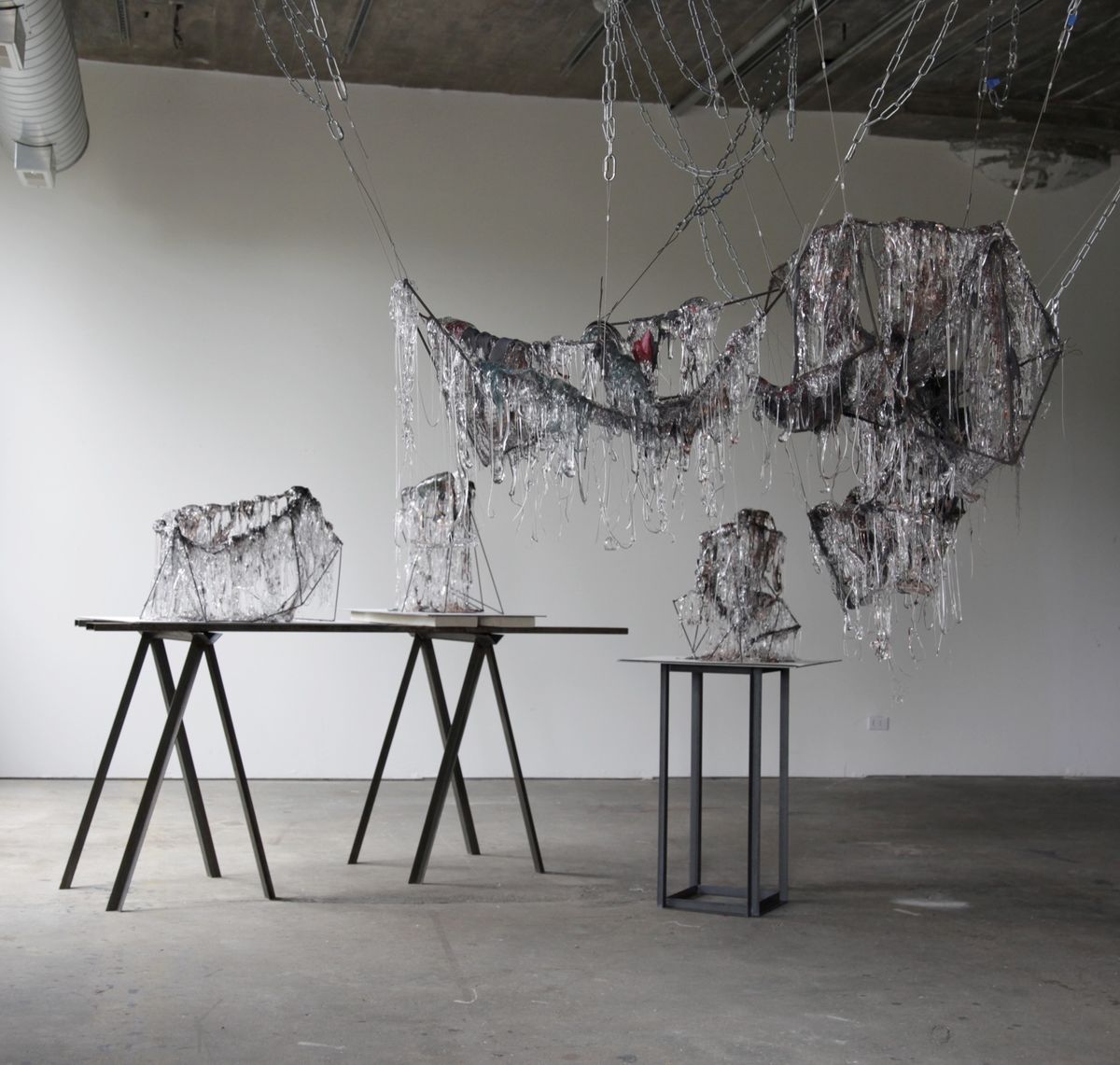
DESIGNBOOM_Glass is a volatile material. Working with it as an artistic medium can involve physical and mental strain, great expense, and a high chance of failure. And yet artists and designers who work with glass can shape it into anything from ethereal vessels to dynamic installations that resemble liquid. Glass is unmatched when it comes to the creative potential it offers.
Dutch artist Krista Israel sees working with glass, at times, as an obsession. “For me, it is not just any material I work with—I live, breathe, and think in glass,” she said. “It gave me a voice to tell my narrative and shape concepts.” Arriving at such a stage of mastery requires finely honed skills and trustworthy collaborators, not to mention a keen understanding of the medium.
“Glass is often used by artists, designers, and makers who don’t have much background in it,” explained Irish artist Karen Donnelan. “I think understanding some of the properties of glass and its history is a good starting point to making great work with the material.” A lack of this understanding, she added, can lead to derivative work.

Ayako Tani, Ghost 3, 2010 . Courtesy of the artist.
But glass artists who focus solely on the medium have often been overlooked in the past. As American artist Deborah Czeresko noted, glass has “been pigeonholed as a craft material.” Only recently, she added, it has caught the attention of the larger art market.
Glass institutions like the Corning Museum of Glass and UrbanGlass have helped make the material accessible to more artists, Czeresko said. The Corning Museum’s show “New Glass Now,” which runs from May 12, 2019, to January 5, 2020, features 100 works by artists working in more than 25 countries who are taking fresh, innovative approaches to the medium. Below, we share the insights of 10 of the participating artists on the greatest challenges and rewards of working with glass, and what it takes to excel with it. (Editor’s note: The artists’ responses have been edited for length and clarity.)
Rui Sasaki
B. 1984, Japan. Lives and works in Kanazawa, Japan.

Rui Sasaki, Liquid Sunshine/I am a Pluviophile, 2018. Courtesy of Yasushi Ichikawa and the Corning Museum of Glass.
Can you tell us a bit about your work?
Liquid/Sunshine/I am a Pluviophile (2018) is inspired by unstable weather in the Hokuriku region, where I live in Japan. There are more than 200 raindrop-shaped glass pieces with phosphorescent material hanging from the ceiling in a darkened room with a motion detector.
What does it take to excel with glass?
I need a lot of practice and have to experiment often to get skills and learn knowledge to know glass enough to fully explore it in my work. There are so many failures in the process. However, I believe that failures and experiments are the only way to break through and to let me achieve what I am most interested in with glass.
What is something you can do with glass that you can’t do with other mediums?
Glass has so many characteristics and phenomena as a material—such as reflection, transparency, fragility, strength, and so on—to work with to make a project. What other mediums have these unique characteristics to work with?
Stine Bidstrup
B. 1982, Denmark. Lives and works in Copenhagen, Denmark.

Stine Bidstrup, Bifurcation, 2017. Courtesy of Corning Museum of Glass.
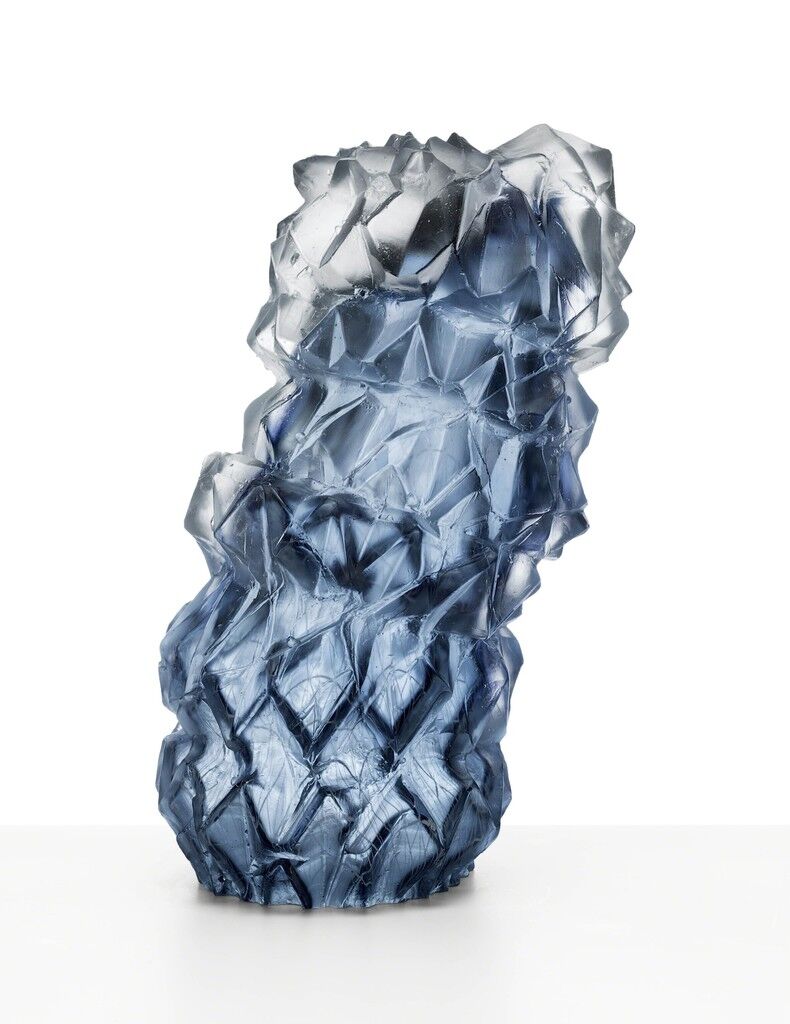 STINE BIDSTRUPARCHITECTURAL GLASS FANTASIES SERIES - OBJECT NO. 9
STINE BIDSTRUPARCHITECTURAL GLASS FANTASIES SERIES - OBJECT NO. 9
Can you tell us a bit about your work?
My work exists at the cross section of sculpture, craft, and installation art; it’s inspired and informed by the history of architecture and design.
My work in “New Glass Now” is based on an interest in patterns of people, infrastructure, architecture, and systems that have grown so large and out of proportion to their original purpose that they lose touch with human reason and understanding.
What is the greatest challenge you face in working with glass?
Glass is far from an easy material to work with, generally speaking, and I tend to make a hard thing harder by developing several complex ways of creating form and pattern and combining them into one work. I use a spectrum of techniques—glassblowing, glass-casting, fusing and stretching, cold-working, gluing, painting, etc.—in my pieces to create dense layers of information and meaning.
What does it take to excel with glass?
In order to be able to develop your own voice with glass, I believe it is important, early on, to be in a learning environment where you are led to question established notions and potential clichés of what glass is in an art and design context.
It takes a very determined willpower to continue working with it for years and stick with for a lifetime. For me, it has to make sense in a conceptual way to keep working with glass, because there are many other materials and mediums that are more approachable. I do it because glass triggers curiosity and an engaged and complex viewing relationship between the objects and the audience.
Krista Israel
B. 1975, the Netherlands. Lives and works in Amersfoort, the Netherlands.
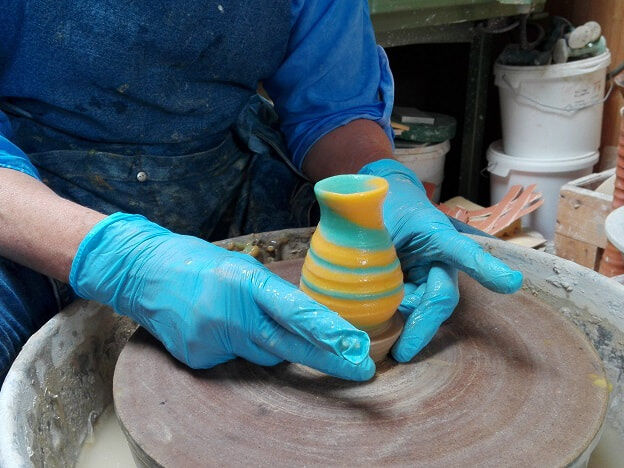
Krista Israel, Ayako Tani, and Hans de Kruijk, Lapi Boli Project, Netherlands, 2018. Photo by Krista Israel. Courtesy of the artist.
Can you tell us a bit about your work?
My use of multiple techniques to arrive at complex works is based on the complexity of society. I try to capture its ambiguity in layered, ambiguous works that touch both personal and universal feelings. No ready-made solutions, but moments of reflection.
What is the greatest challenge you face in working with glass?
Reinventing myself as an artist over and over again and developing skills are my greatest challenges in working with glass.
What does it mean to excel in working with glass?
Eighteen months ago, I found myself influenced by something I had no control over—a new work environment in the porcelain capital of the world, Jingdezhen, China. The environment led me to develop the experimental project “Lapi Boli”—lapi is the Chinese word for the ceramic throwing technique; boli is glass. It was so exciting, but also so very far out of my comfort zone. Aside from the technical challenge, for me, it is also an emotional challenge to experiment and to give myself the space to walk this new path of becoming an artist/researcher.
I strive to grow by continuing to improve my skills and being open to learning. I brainstorm a lot with “glassie friends” and, if possible, take a course to deepen my skills during a summer academy. Growing my ability to control the material brings me self-confidence, so I can technically implement more complex ideas. It is nice to experience that control, but there must be a balance, so I remain emotionally resilient. It is easy to lose yourself in the pursuit of perfectionism. The strength to keep yourself in balance, and being honest with yourself and the work, is of most importance.
Ayako Tani
B. 1981, Japan. Lives and works in Sunderland, United Kingdom.
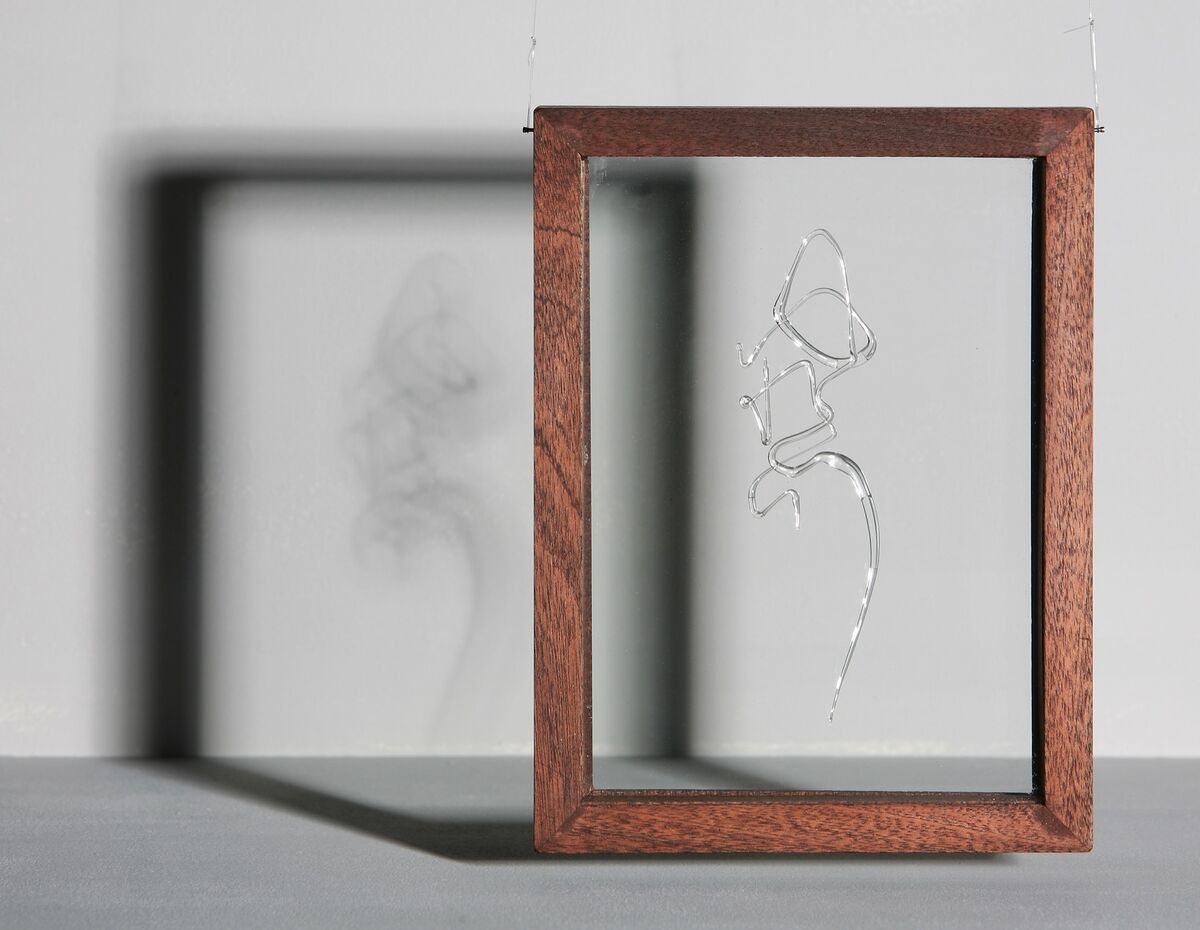
Ayako Tani, Ghost 3, 2010. Courtesy of the artist.
Can you tell us a bit about your work?
I developed the genre of calligraphic lampworking, where glass is used as “ink” to draw spontaneous marks in three-dimensional space. The work is often inspired by my own personal recollections and those of others. Recently, I have been investigating the history of glass ships in bottles made by former Pyrex lampworkers in Sunderland, and applying the skills I have acquired to my new work.
What is the greatest challenge you face in working with glass?
Stretching and bending a rod into a large and perfect circle of a uniform line thickness.
What does it take to excel with glass?
Love of the material and an abiding fascination with its possibilities.
What is something you can do with glass that you can’t do with other mediums?
Freezing the moment when the piece is created in hot glass and preserving this moment for thousands of years.
Fredrik Nielsen
B. 1977, Sweden. Lives and works in Stockholm.
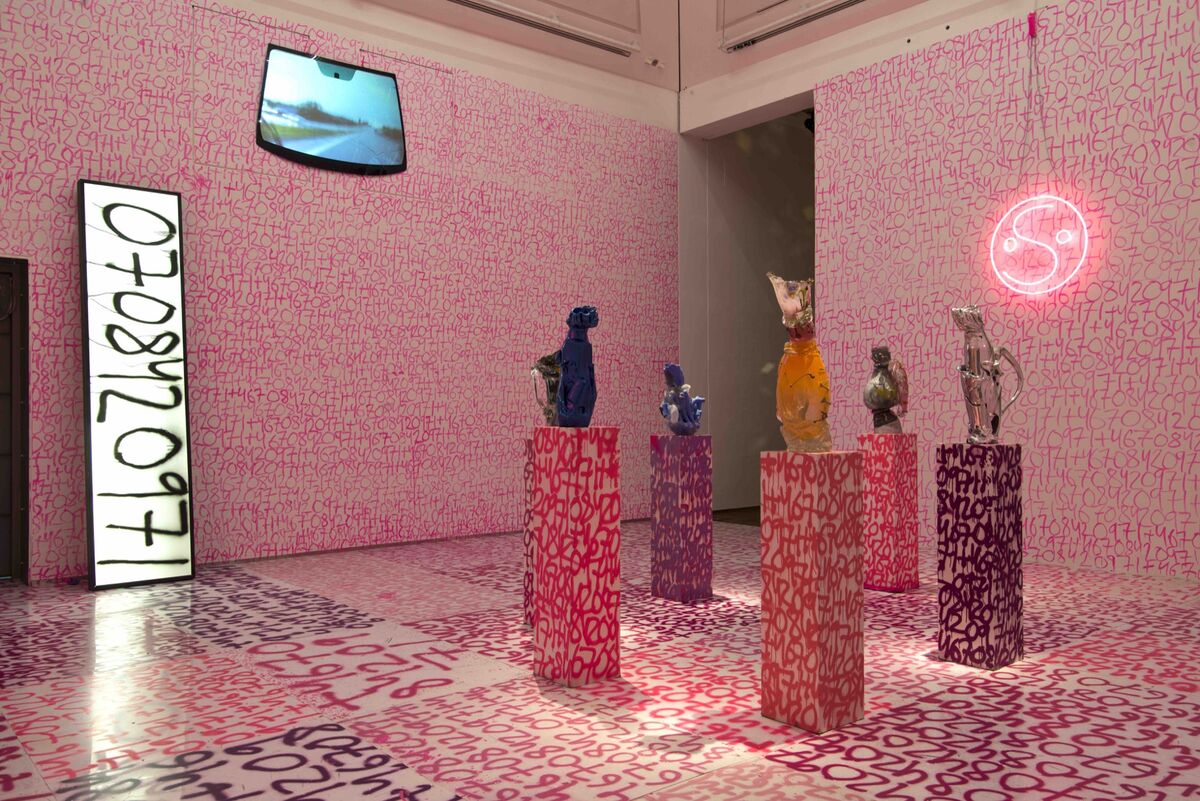
Fredrik Nielsen, I was here, 2017. Courtesy of Dunkers Kulturhus and the Corning Museum of Glass.
Can you tell us a bit about your work?
The work[s] I make are the largest shapes I can manage; I go until I can’t go anymore. The pitcher shape has become a kind of canvas for me. Sometimes I look at the pitchers as a trash can with a handle—the handle, or the grip, makes it into something else. When the piece competes with my own body, I reach a place where I want to be. Glassblowing is my race car, my amplifier, my main material.
What is the greatest challenge you face in working with glass?
It’s just about hitting that right energy level of creation. It’s such hard work, and it’s a lot of technical stuff that’s easily interfering with the connection between the artist and the potential art being made. I guess the challenge is to get rid of that interference and to just be connected. When glass is just technical, you lose all art, but you might win the competition within the field of the craft. I mean where the rulebook is about how stuff is supposed to be made. We all need that, but then turn our back on it if we now want to be artists. My hand holds a language, and if I can get that out there, it becomes something. Lately, I have been thinking a lot about the intelligence of the hand, the silent knowledge, and so on. I think the language of each artists’ hand takes quite a while to become interesting, it’s almost like ideas and choice of color [don’t] matter if you don’t speak your own language really well.
What does it take to excel with glass?
I think it takes so much, especially with glassblowing; the labor is hard to compare with other materials. It’s not for no reason that they call glassblowers “the truck drivers of the art world.” For my own sake, it’s that understanding, that flow, that puts me into motion. When I gather glass, I look at it as a really good glue, the best glue in the world. Thinking about it like that opens up new possibilities. And when I’m able to make stuff that I couldn’t make up beforehand, it makes me understand what glass is. Glass is, for me, the fastest sculptural material there is, and when and if you are ready to connect to that, you’ve got everything going for you. It’s like the best fairytale material there is.
Christine Tarkowski
B. 1967,United States. Lives and works in Chicago.
 Christine TarkowskiWorks from The Chthonic Void,
Christine TarkowskiWorks from The Chthonic Void,
Can you tell us a bit about your work?
I’m an artist who works in a variety of mediums, including textiles and architecture, so this glass sculpture I’m showing at Corning is an extension of my creative practice. The work is a sculpture that relies on drawing with molten materials; hot glass and liquid copper that get alternately poured onto a vague steel armature that “catches” the material as it cools. I approached the sculpture as if it were a three-dimensional drawing, constructed from iterative parts.
What is the greatest challenge you face in working with glass?
Surely the ability to access facilities and collaborating with skilled glass makers. This challenge, however, is one of the unique conditions surrounding glass, which is the social aspect of the making of glass. The process of production is often communal, which in turn allows for a more emergent and collaborative environment.
What is something you can do or achieve with glass that you can’t do with other mediums?
As my background in glass involves training, but is for the most part technically limited, I feel I’m more able to create experimental yet informed works than I would be able to with another medium. Glass can yield unimaginable results if one approaches the material with an ethos toward observation and discovery.
Qin Wang
B. 1978, China. Lives and works in Shanghai.
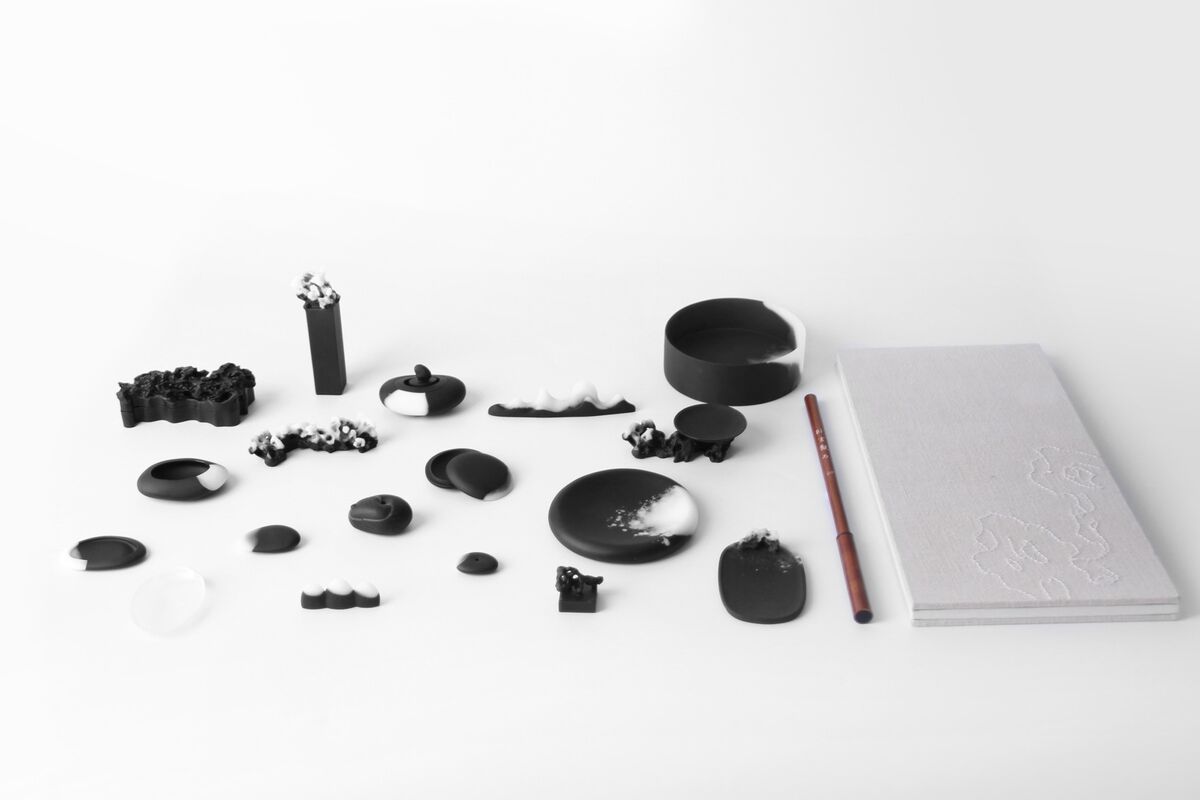
Qin Wang, Four Treasures, 2016. Courtesy of the Corning Museum of Glass.
Can you tell us a bit about your work?
By using the character of glass, I try to show the space between the spirit and the object. In the spirit of the zen narrative, I want to express a unique Asian perspective. My work Four Treasures takes inspiration from the silence of nature. The aesthetic focus of this artwork is opacity, immateriality, and silence. I constantly try to push beyond the boundaries of light and glass material by studying their properties.
What is the greatest challenge you face in working with glass?
Serendipity fascinates me. It is beyond our control and understanding; unpredictable and unexpected. In my artwork, glass melting in the kiln is a zen moment. This method of creation is like an exploration, providing a world of possibilities. It decreases the acts and traces of human intention. The pursuit requires keen intuition and a rich experience. Magic can happen.
I respect glass as a material, and don’t want to control it. I try to talk to the glass and understand it; merge with it to achieve an utterly harmonious connection between my heart and the material.
Deborah Czeresko
B. 1961, United States. Lives and works in New York.

Deborah Czeresko, Meat Chandelier, 2018. Photo by Jess Julius. Courtesy of the Corning Museum of Glass.
Can you tell us a bit about your work?
The work I create in glass addresses the hand and making as subject matter. Specifically, my thematic approach addresses the gendering of occupation and object through the lens of a mythical Renaissance
Venetian glass maestro who is female. The work fuses the history and tradition of chandelier- and glass-manufacturing with the relationships of gender and mastery through the skill-laden culture of the glass studio.
The most recent piece in the series is included in “New Glass Now.” This elaborate light fixture, called Meat Chandelier, references traditional Italian chandeliers, typically depicting complex floral arrangements. I subvert these visual markers and render accurate pieces of meat out of glass in place of the frilly floral motifs. Hot dogs are tethered together; logs of salami, as well as prosciutto, dangle; and a pork chop flaps at the center.
What does it take to excel with glass?
Becoming proficient at hand-formed hot glass is a painstaking process, which is deceptively simple. It takes a huge investment of time and thousands of mistakes to get to a level where execution is fluid and natural. Weather conditions matter; temperature and humidity place strain on the body. It helps to condition oneself physically so the body is not a limiting factor to making in the demanding hot shop.
Glass requires complete mental focus to merge with the material technically. Once a piece starts, you must drive the process forward with no breaks; you cannot put it down and come back later. It’s an extended state of focus or meditation on the process that is very demanding and dynamic, mentally and physically. There is a bizarre disconcerting psychological element to glassmaking.…I fall in love with pieces that are still on the blowpipe that I have invested a lot of time and energy into, then force myself to subdue this passion because the material is so complicated and fragile that it can break or be lost at any step in the process.
What is something you can do or achieve with glass that you can’t do with other mediums?
Glass is a phenomenological material rich with mineable metaphorical qualities. It transforms from one state to the next in a viscous primordial ooze. Its scientific state is considered a supercooled liquid or an amorphous solid. This transmutational nature makes me think of glass as genderless or gender-malleable; this aspect informs the narrative of my work and is not present in many other materials.
Obviously, glass has transparency and delicacy going for it, and associations to spirituality, science, and futuristic aspects, as well, that can be harvested for content. You can freeze the fluid ooze in motion or capture organic matter in a glass bubble and watch it incinerate. Glass breaks in interesting ways that can turn a seemingly docile and soft form into a razor-sharp weapon. It is capable of reflection through mirroring. It can glow under UV light by adding inert Uranium. Huge masses of it can appear weightless and ghostly, such as the work of Roni Horn
.
Karen Donnellan
B. 1986, Ireland. Lives and works in Alfred, NewYork.
![]()
Suzanne Peck and Karen Donnellan, Blow Harder: Alternative Lexicons for the Hotshop, 2018. Courtesy of the Corning Museum of Glass.
![]()
Can you tell us a bit about your work?
I make sculptural works, video, sound, and performance. Some works use glass, some don’t, but my training in glass and my love of the material does inform my material choices.
The work I’ll be showing as part of “New Glass Now” is based on a collaboration with Suzanne Peck. It began as a research paper titled “Blow Harder: Language, Gender, and Sexuality in the Glass Blowing Studio.” The work is a poster with alternative lexicons for the usually gendered—and sometimes problematic—glassblowing terms. Our poster offers “neutral,” “feminist,” and some ridiculous “highbrow” alternatives—e.g., the usual term “glory hole” could be “reheating chamber” (neutral); “g-spot” (feminist); or “chamber of life-affirming heat” (highbrow).
What is the greatest challenge you face in working with glass?
That I am seen as a “glass artist” or craftsperson, and as such, the research and ideas in my work are dismissed or not seen. I also work with a lot of other media, and I don’t always fabricate the work myself, so the term “glass artist” is not very accurate anyway.
What is something you can do with glass that you can’t do with other mediums?
It’s not one specific thing, but other materials that are glass-like—e.g., plastic/resin, wax, cellophane, quartz, ice, water—can only replicate certain qualities of glass. None have the archivability, transparency, weight, optics, magnification, and clarity, or can be manipulated using the wide range of ways that glass can (casting, fusing, blowing, cutting, polishing, flameworking, stained glass, etc.). They also don’t have a history like glass does, and few are at the bleeding edge of technology like glass is!
Jahday Ford
B. 1994, Bermuda. Lives and works in Manchester, United Kingdom.
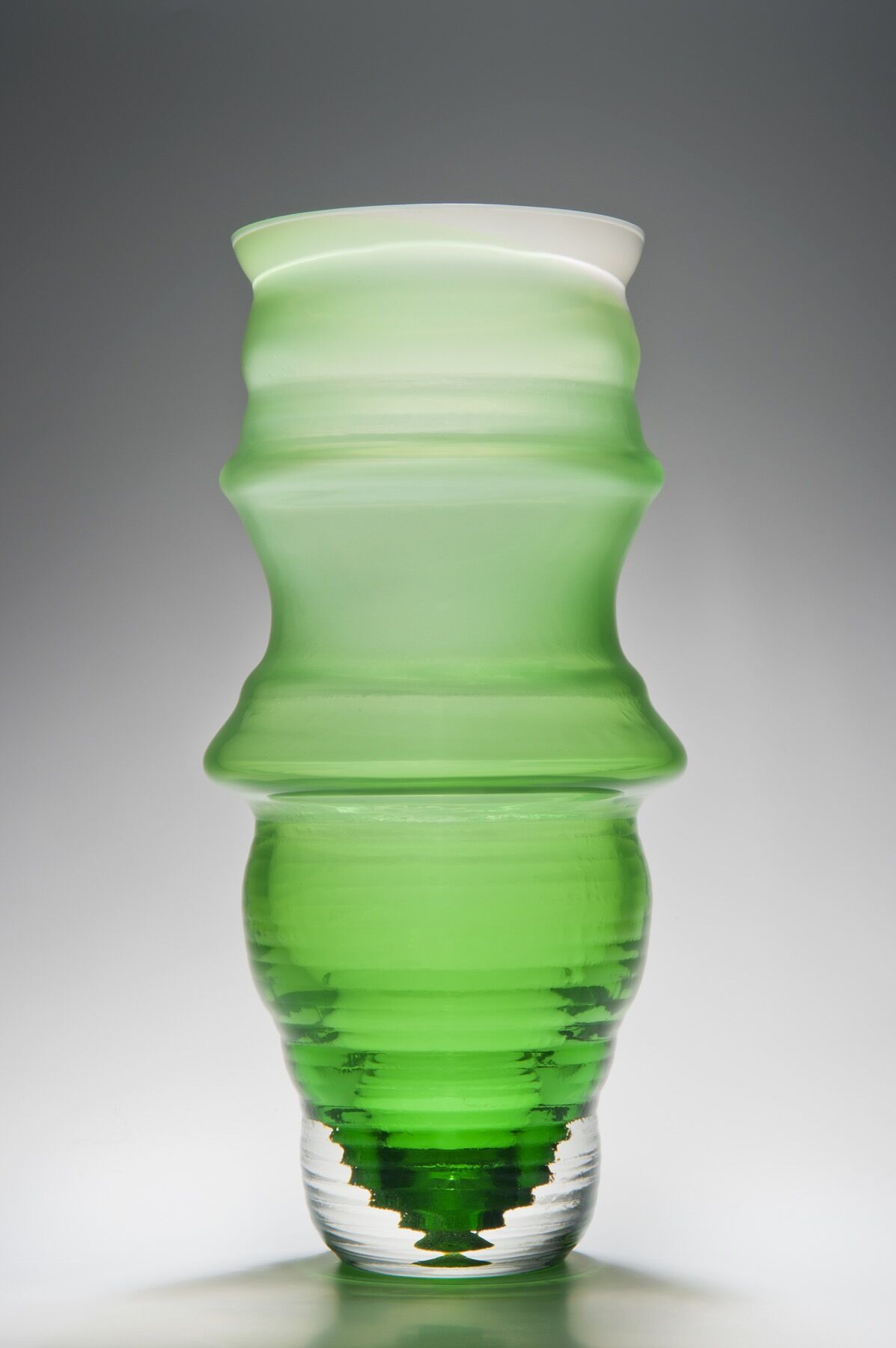
Jahday Ford and Joseph Hillary, Breathe, 2017. Photo by Ester Segarra. Courtesy of the Corning Museum of Glass.
Can you tell us a bit about your work?
Many of my creations involve the manipulation of glass materiality beyond its decorative normality. Experimenting with mixed materials and digital processes allows the state of the semi-fluid material to manifest in peculiar intricacies and formats you’d never be able to predict. This curiosity keeps me constantly testing for more discoveries.
What is the greatest challenge you face in working with glass?
The modern-day life of glassmaking, realistically, has proven to be shockingly challenging outside of university, as a postgrad. Hot-shop hires, equipment fees, travel, shipping, assistants, studio fees, packaging, cold-working, glass color—the list goes on. All the while, you’re making sure your bills are covered and you’ve got a nice plate of risotto at the end of the day. Amid all of these hardships and high expenses as a freelance maker in glass, I’ve never lost the eagerness to pursue professional making. It gives me a feeling of chasing something special and discovering more with the material, even though it costs me an arm and a leg.
What does it take to excel with glass?
Working in hot glass, specifically, requires the utmost respect for the material. It’s actually alive, with a very short lifespan, if you think about it. You can’t just put it down, have a break, and take your time with it. If you don’t respect or connect to the material first, the work you make won’t come out as you’d like, and you can seriously injure yourself and others in a staggering amount of ways. Once you control these elements within your making, you can push your work to such a higher level.
Often, you may not want to focus on massive pieces or master-level techniques—this spurs exciting room for collaboration or working with more experienced makers in other mediums. If I didn’t jump to investigate my practice, or challenge my knowledge, by working with other like-minded creatives, I never would have discovered the areas of glass I work in, designing molds, creating digital methods, and using unusual techniques.
